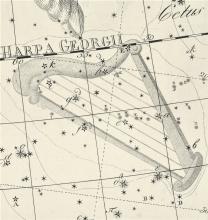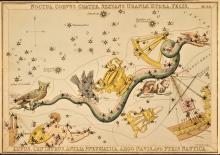Listen to today's episode of StarDate on the web the same day it airs in high-quality streaming audio without any extra ads or announcements. Choose a $8 one-month pass, or listen every day for a year for just $30.
You are here
Corvus
You can organize a constellation’s stars in many ways — by brightness, color, or position, for example. But a system that astronomers have been using for centuries can’t quite make up its mind. In most constellations, it goes by brightness. In others, it’s based on position. And in some, there doesn’t seem to be a guiding principle at all.
An example of the latter is Corvus, the crow. It’s low in the southeast at nightfall, to the right of the bright star Spica, the leading light of Virgo.
Four stars form an angled box that looks like a sail. A fainter star is near the right point of the sail. Yet it receives top billing.
The naming system was devised more than four centuries ago by German astronomer Johann Bayer. He labeled the bright stars in each constellation with the letters of the Greek alphabet. “Alpha” usually designated the brightest star. In some instances, though, the title went to a star that was the starting point for an easily defined pattern.
But in the case of Corvus, Bayer doesn’t seem to have followed any pattern at all. The stars aren’t named from top to bottom, left to right, or in a circle. They don’t form any logical order within the figure of the crow, either.
And the Alpha star is only the fifth-brightest in the constellation — a faint pinpoint that’s visible only under dark skies.
So no one is quite sure what Bayer was thinking when he named the stars of this pretty little constellation.
Script by Damond Benningfield






